INSTITUT SUPERIEUR D'ANTHROPOLOGIE
INSTITUTE OF ANTHROPOLOGY
ONLINE COURSES / COURS A DISTANCE
INSCRIPTION 2012 / Session III : Juillet 2012
REGISTRATION 2012 / Term III : July 2012
PEROU – 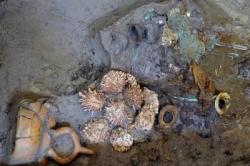 Chotuna-Chornancap - Archeologists said Friday they have discovered a tomb about 1,200 years old, from the pre-Inca Sican era, in northern Peru. Human remains and jewelry were found July 4 along with the tomb, likely that of a member of the aristocracy of the Sican or Lambayeque elite, head researcher Carlos Wester La Torre told AFP. A gold earflap, a silver-plated crown, and some 120 silver and copper ornaments that served as emblems of power, along with 116 pieces of pottery and seashells were found in the tomb. The tomb was located in a burial chamber some six meters (20 feet) deep in the Chotuna-Chornancap sanctuary near Chiclayo, at the same location where the remains of a Sican priestess were found in October. "This discovery is very important because we now know one of the elite classes of Lambayeque culture," said Wester La Torre, speaking from Chiclayo, capital of the Lambayeque region. The Sican culture, also referred to as the Lambayeque culture, worshipped the Sican Lord. It emerged between 700 and 750 AD, remaining in force until 1375, reaching its high point between 900 and 1100. At that time, there were about seven to eight "Sican lords" representing heavenly powers on Earth, complete with masked face, upturned eyes and pointed ears.
Chotuna-Chornancap - Archeologists said Friday they have discovered a tomb about 1,200 years old, from the pre-Inca Sican era, in northern Peru. Human remains and jewelry were found July 4 along with the tomb, likely that of a member of the aristocracy of the Sican or Lambayeque elite, head researcher Carlos Wester La Torre told AFP. A gold earflap, a silver-plated crown, and some 120 silver and copper ornaments that served as emblems of power, along with 116 pieces of pottery and seashells were found in the tomb. The tomb was located in a burial chamber some six meters (20 feet) deep in the Chotuna-Chornancap sanctuary near Chiclayo, at the same location where the remains of a Sican priestess were found in October. "This discovery is very important because we now know one of the elite classes of Lambayeque culture," said Wester La Torre, speaking from Chiclayo, capital of the Lambayeque region. The Sican culture, also referred to as the Lambayeque culture, worshipped the Sican Lord. It emerged between 700 and 750 AD, remaining in force until 1375, reaching its high point between 900 and 1100. At that time, there were about seven to eight "Sican lords" representing heavenly powers on Earth, complete with masked face, upturned eyes and pointed ears.
http://au.news.yahoo.com/entertainment/a/-/entertainment/14232115/ancient-pre-inca-tomb-found-in-northern-peru/
FRANCE – 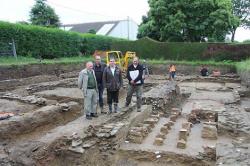 Carhaix - Tout a commencé en 2008, lorsque M. et Mme Cudonnec ont acheté un terrain de 480 m 2 pour y faire construire leur maison. Leur souhait était qu'elle soit proche du centre-ville de Carhaix. Trois ans après, toujours pas de nouvelle maison, mais les vestiges de deux insulae (habitations de la Rome antique), situées au bord d'une ancienne voie romaine s'étalant du nord au sud de la ville. Selon les archéologues, ces deux résidences privées ont pu abriter des Romains entre le I er et le IV e siècle de notre ère, lorsque Carhaix, alors dénommée Vorgium, était capitale de cité de la Bretagne. L'opération d'archéologie préventive est sur le point de se terminer. Elle aura permis la sauvegarde par l'étude de ces vestiges, avant la poursuite des travaux sur la parcelle. « Les vestiges sont dans un excellent état de conservation car il ne s'était rien passé sur le sol depuis la période gallo-romaine. Ils permettent une très bonne lecture de l'histoire » explique Mélanie Scellier, chargé de développement au sein de l'Inrap. « Ces vestiges nous permettent presque de voir les évolutions des maisons en direct et en particulier les différences de choix techniques et architecturaux entre deux propriétaires contemporains mais aussi l'évolution d'un quartier sur plus de quatre siècles d'occupation » complète Didier Rigal, responsable de l'opération de chantier. Plusieurs éléments de décor et de mobilier tels que des enduits peints, de la céramique, du verre à vitre ou encore du bleu d'Égypte (très cher) témoignent de l'opulence de ces résidences. Un caractère renforcé par la présence des ruines d'un établissement thermal lié à l'une d'elles. Et contrairement à ce que l'on peut croire, le chauffage au sol ne date pas du XX e siècle puisque ces Romains l'utilisaient déjà. L'air était chauffé en sous-sol grâce à un système de pilotis et remontait par des « tubulis » (canalisation de chauffage) placés entre les murs. Les scientifiques précisent que l'intérêt de cette opération réside aussi dans la découverte d'un puits répondant sans doute aux besoins d'approvisionnement en eaux des habitants du quartier. Un élément de connaissance supplémentaire sur l'organisation de la ville antique. D'autant qu'à l'intérieur de la cavité, ils ont pu dénicher un fragment d'articulation sculpté dans du marbre d'Italie, appartenant sans doute au coude ou au genou d'une statue à taille humaine. Probablement le maire de la cité.
Carhaix - Tout a commencé en 2008, lorsque M. et Mme Cudonnec ont acheté un terrain de 480 m 2 pour y faire construire leur maison. Leur souhait était qu'elle soit proche du centre-ville de Carhaix. Trois ans après, toujours pas de nouvelle maison, mais les vestiges de deux insulae (habitations de la Rome antique), situées au bord d'une ancienne voie romaine s'étalant du nord au sud de la ville. Selon les archéologues, ces deux résidences privées ont pu abriter des Romains entre le I er et le IV e siècle de notre ère, lorsque Carhaix, alors dénommée Vorgium, était capitale de cité de la Bretagne. L'opération d'archéologie préventive est sur le point de se terminer. Elle aura permis la sauvegarde par l'étude de ces vestiges, avant la poursuite des travaux sur la parcelle. « Les vestiges sont dans un excellent état de conservation car il ne s'était rien passé sur le sol depuis la période gallo-romaine. Ils permettent une très bonne lecture de l'histoire » explique Mélanie Scellier, chargé de développement au sein de l'Inrap. « Ces vestiges nous permettent presque de voir les évolutions des maisons en direct et en particulier les différences de choix techniques et architecturaux entre deux propriétaires contemporains mais aussi l'évolution d'un quartier sur plus de quatre siècles d'occupation » complète Didier Rigal, responsable de l'opération de chantier. Plusieurs éléments de décor et de mobilier tels que des enduits peints, de la céramique, du verre à vitre ou encore du bleu d'Égypte (très cher) témoignent de l'opulence de ces résidences. Un caractère renforcé par la présence des ruines d'un établissement thermal lié à l'une d'elles. Et contrairement à ce que l'on peut croire, le chauffage au sol ne date pas du XX e siècle puisque ces Romains l'utilisaient déjà. L'air était chauffé en sous-sol grâce à un système de pilotis et remontait par des « tubulis » (canalisation de chauffage) placés entre les murs. Les scientifiques précisent que l'intérêt de cette opération réside aussi dans la découverte d'un puits répondant sans doute aux besoins d'approvisionnement en eaux des habitants du quartier. Un élément de connaissance supplémentaire sur l'organisation de la ville antique. D'autant qu'à l'intérieur de la cavité, ils ont pu dénicher un fragment d'articulation sculpté dans du marbre d'Italie, appartenant sans doute au coude ou au genou d'une statue à taille humaine. Probablement le maire de la cité.
http://www.ouest-france.fr/2012/07/14/cotes-d-armor/Un-quartier-de-la-ville-antique-de-Vorgium-exhume--63246329.html
AZERBAIDJAN – 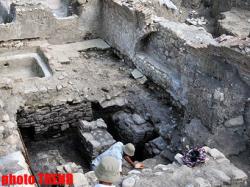 Kravelabi - Items relating to the first millennium BC have been found during archaeological excavations in Lerik (325 km from Baku), conducted by the Institute of Archaeology and Ethnography of Azerbaijan National Academy of Sciences in cooperation with the National Centre for Scientific Research and the National Museum of the Paris Saint-Germain. Patterns of material culture have been found in the burials in stone boxes of Kravelabi II during excavations in the village Kravelabi of Lerik region, head of the international archaeological expedition, head of the Institute of Archaeology and Ethnography, Ph.D. Abuzer Alekperov told Trend on Monday. He said the findings relate to the early Iron Age and consist of a leaf-shaped tip of a spear, an iron ring, glass beads and other materials, red pottery and other items typical of the early Iron Age. The expedition has also conducted preliminary excavations at sites of Kravelabi III and Kravelabi IV, where dolmen burials lined with limestone have been found. Archaeological researches had not been carried out in Lerik region for a long time. Azerbaijani and French archaeologists are conducting archaeological excavations as part of the Study of Heritage project by Jacques de Morgan. French archaeologist Jacques de Morgan conducted archaeological excavations in the south eastern region of Azerbaijan in the late 19th century and took his findings to Paris. These findings will be involved in the joint research. An international exhibition will be organised which will exhibit the patterns of the material culture of Azerbaijan.
Kravelabi - Items relating to the first millennium BC have been found during archaeological excavations in Lerik (325 km from Baku), conducted by the Institute of Archaeology and Ethnography of Azerbaijan National Academy of Sciences in cooperation with the National Centre for Scientific Research and the National Museum of the Paris Saint-Germain. Patterns of material culture have been found in the burials in stone boxes of Kravelabi II during excavations in the village Kravelabi of Lerik region, head of the international archaeological expedition, head of the Institute of Archaeology and Ethnography, Ph.D. Abuzer Alekperov told Trend on Monday. He said the findings relate to the early Iron Age and consist of a leaf-shaped tip of a spear, an iron ring, glass beads and other materials, red pottery and other items typical of the early Iron Age. The expedition has also conducted preliminary excavations at sites of Kravelabi III and Kravelabi IV, where dolmen burials lined with limestone have been found. Archaeological researches had not been carried out in Lerik region for a long time. Azerbaijani and French archaeologists are conducting archaeological excavations as part of the Study of Heritage project by Jacques de Morgan. French archaeologist Jacques de Morgan conducted archaeological excavations in the south eastern region of Azerbaijan in the late 19th century and took his findings to Paris. These findings will be involved in the joint research. An international exhibition will be organised which will exhibit the patterns of the material culture of Azerbaijan.
http://en.trend.az/news/society/2047175.html
TURQUIE - Boncuklu Höyük - The team, headed by Dr Andrew Fairbairn from the University of Queensland, will join with a British team next week to continue work on the excavation of a 10,000-year-old early village site in central Turkey. The site, known as Boncuklu Höyük, is one of the earliest village sites found from the period when hunter-gatherer societies began to leave their nomadic lifestyle and take up farming. Villagers lived in oval-shaped, mud brick houses and hunted, farmed and traded with other local communities on an area of wetlands which is now a dusty plain near the city of Konya. "It's come to be one of the key transformations in human history because, basically, the development of our civilisations is routed in a lot of these social and economic transformations that happened around about this time," Dr Fairbairn told ABC News Online. He says the site is one of the earliest found just outside the key Fertile Crescent area of eastern Turkey, Syria and Jordan where it is thought farming first originated. The site is expected to help archaeologists understand how humans adapted to a sedentary lifestyle and how it spread across Europe.
http://www.radioaustralia.net.au/international/2012-07-16/ancient-village-holds-lifestyle-clues-for-archaeologists/980932
USA – 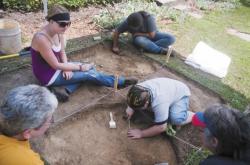 Meigs County - An archaeological dig in Meigs County last week may help uncover the past of a pre-Civil War era home. While there's uncertainty about some of the facts surrounding the house, Shaw explained that its original owner was likely Orville Jones. His mother, Deiadamia Jones, a wealthy widow from New York, moved Orville and his brother Leroy to Meigs County around 1860. At that time, she remarried and had both Orville and Leroy's houses built just down the road from each other.
Meigs County - An archaeological dig in Meigs County last week may help uncover the past of a pre-Civil War era home. While there's uncertainty about some of the facts surrounding the house, Shaw explained that its original owner was likely Orville Jones. His mother, Deiadamia Jones, a wealthy widow from New York, moved Orville and his brother Leroy to Meigs County around 1860. At that time, she remarried and had both Orville and Leroy's houses built just down the road from each other.
http://www.athensnews.com/ohio/article-37339-archaelogical-project-seeks-to-uncover-1800s-farmhouses-past.html
ROYAUME UNI – 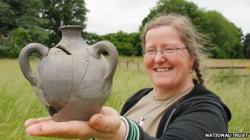 Corfe Castle - A three-handled pot that baffled archaeologists for 26 years has been displayed for the first time with its proper identity tag - a grenade. Fragments of the pot were uncovered at Corfe Castle, Dorset, in 1986. In May a Dutch archaeologist recognised it on a Facebook posting as a smoke bomb from Vlissingen in the Netherlands. National Trust archaeologist Nancy Grace who found the fragments said: "We knew it was from continental Europe but the best guess was that it might be a piece of tableware, possibly an oil pot." The Dutch archaeologist however identified it as a Dutch "stankpot" - a smoke bomb or grenade. A fuse would be suspended from the three handles and then the pot filled with an explosive or smoke producing mixture. Ms Grace said: "It is great to finally find out what it is."
Corfe Castle - A three-handled pot that baffled archaeologists for 26 years has been displayed for the first time with its proper identity tag - a grenade. Fragments of the pot were uncovered at Corfe Castle, Dorset, in 1986. In May a Dutch archaeologist recognised it on a Facebook posting as a smoke bomb from Vlissingen in the Netherlands. National Trust archaeologist Nancy Grace who found the fragments said: "We knew it was from continental Europe but the best guess was that it might be a piece of tableware, possibly an oil pot." The Dutch archaeologist however identified it as a Dutch "stankpot" - a smoke bomb or grenade. A fuse would be suspended from the three handles and then the pot filled with an explosive or smoke producing mixture. Ms Grace said: "It is great to finally find out what it is."
http://www.bbc.co.uk/news/uk-england-dorset-18842043
TURQUIE – 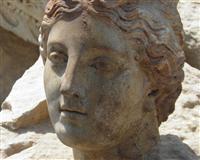 Parion - Excavations in the Parion Ancient City situated in Kemer village in Biga, have uncovered a sculpture of Artemis that spans back 1,800 years. The Parion archaeological excavations, led by Erzurum's Atatürk University Archeology Department Professor Dr. Cevat Başaran in conjunction with the Ministry of Culture and Tourism with İÇDAŞ A.Ş as the main sponsor, are being conducted by students from universities throughout Turkey who are currently working on six different sections of the ancient site. The marble sculpture was found in separate pieces at the Odeon (small theater) section of the excavation.Prof. Dr. Başaran explains that the sculpture of a clothed woman dated back 1,800 years, was approximately one meter, 70 centimeters in length and was carved from high-quality marble. Başaran stated that a number of marble sculptures representing animals such as sheep and dogs were also found near the sculpture, which he referred to as, "belonging to the goddess of hunting and wilderness Artemis as evident by the bow and arrow she holds in her hands."
Parion - Excavations in the Parion Ancient City situated in Kemer village in Biga, have uncovered a sculpture of Artemis that spans back 1,800 years. The Parion archaeological excavations, led by Erzurum's Atatürk University Archeology Department Professor Dr. Cevat Başaran in conjunction with the Ministry of Culture and Tourism with İÇDAŞ A.Ş as the main sponsor, are being conducted by students from universities throughout Turkey who are currently working on six different sections of the ancient site. The marble sculpture was found in separate pieces at the Odeon (small theater) section of the excavation.Prof. Dr. Başaran explains that the sculpture of a clothed woman dated back 1,800 years, was approximately one meter, 70 centimeters in length and was carved from high-quality marble. Başaran stated that a number of marble sculptures representing animals such as sheep and dogs were also found near the sculpture, which he referred to as, "belonging to the goddess of hunting and wilderness Artemis as evident by the bow and arrow she holds in her hands."
http://english.sabah.com.tr/Travel/2012/07/12/1800-yearold-artemis-sculpture-found
GRECE - Argos Orestiko : bilan des fouilles en cours.
http://portal.kathimerini.gr/4dcgi/_w_articles_kathbreak_1_01/07/2012_449901